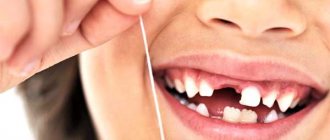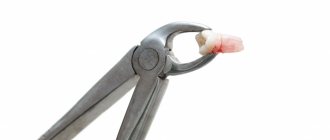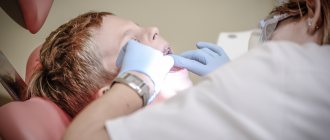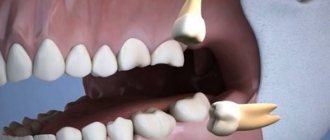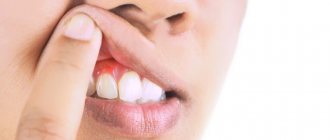From this article you will learn:
- timing of removal of temporary teeth,
- how this procedure is performed at the dentist,
- How to pull out a child's baby tooth at home.
Removal of a baby tooth is a surgical procedure that is performed in pediatric dentistry, for example, to remove “retained” primary teeth (i.e., those that have lingered in the oral cavity longer than they should). The second group of reasons that may require the removal of baby teeth in children is 1) some types of traumatic injuries, 2) with complicated caries, i.e. with the development of inflammation at the apex of the root of a baby tooth.
The physiological change of baby teeth to permanent ones normally begins in a child at 6-7 years of age (and in girls, the loss of baby teeth reliably begins earlier and proceeds faster than in boys). The last thing children lose is their temporary second molars, which should happen around 12-13 years of age. The appearance of mobility of baby teeth is associated with the growth of the rudiments of permanent teeth in the jaw. An increase in their size leads to pressure on the roots of baby teeth, which leads to resorption of the latter (i.e., their resorption).
Removing a baby tooth in a child: photo
Increasing root resorption over time leads to the fact that the baby tooth ceases to be fixed in the bone tissue of the jaw, and will be held only by the soft tissue of the gums. Parents are very often interested in how to pull out a baby tooth (for example, in a situation where a child’s baby tooth is very loose). This can be done quite simply only with strong tooth mobility, which will indicate that the roots of the baby tooth have been almost completely resorbed.
Pay attention to the timing of baby teeth loss in Table No. 1. Both teething and tooth loss (regardless of whether they are milk or permanent) occur in compliance with the timing, pairing rules, and sequence. Parents often ask: what to do in a situation where a molar is already growing, but the baby tooth has not fallen out. The fact is that sometimes the growth and eruption of the permanent tooth germ may occur in the wrong direction, and in this case the roots of the baby tooth will not undergo significant resorption (accordingly, there will not be much mobility).
Removal of baby teeth in children in such a situation can only be performed by a dentist (under local anesthesia or sedation). Believe me, you should not try to pull out a child’s baby tooth yourself if the tooth has only slight mobility or is immobile. The latter will mean that the roots of the baby tooth are not sufficiently resorbed and are still deeply embedded in the bone tissue.
Important: if the deadline for replacing a baby tooth has already arrived (see table), but the baby tooth has no mobility, and there are no signs of eruption of a permanent tooth, this may indicate the absence of a permanent tooth germ or its injury, or its death as a result development of inflammation at the roots of a baby tooth. In this case, the temporary baby tooth can remain for quite a long time, and this situation does not require its removal.
Content:
- Causes of the anomaly
- What does a “shark” smile lead to?
- When to see a doctor
- When to hesitate to see a doctor
- How is the treatment carried out?
The situation when a molar has erupted, but the milk tooth is in no hurry to leave its place, dentists call a “shark” bite. This is due to the fact that sharks also have units arranged in two rows. In humans, such an anomaly does not look aesthetically pleasing at all. Parents usually get very scared when they see a “double” smile on their child. Should I be concerned if a tooth comes out but the baby tooth does not fall out, and what could this lead to? Let's figure it out together.
When should this not be done?
There are more contraindications to independent attempts at removal. These include the following signs:
- the tooth is slightly mobile - the process of loss has just begun;
- the child is in pain;
- there is gum bleeding, swelling or redness;
- touching the tooth causes discomfort;
- the child experiences severe fear and refuses manipulation.
You should not intervene if the child is unwell—suffers from ARVI, has a high fever, has signs of stomatitis, or other inflammatory diseases of the oral cavity.
Causes of the anomaly
If the permanent tooth is erupting but the baby tooth has not fallen out, it can be assumed that the child is not eating enough solid food. With a deficiency of chewing load, the roots of temporary units are in no hurry to dissolve.
The diet of modern children is indeed too “gentle”, one might even say refined. It consists of products that have undergone step-by-step heat treatment. Chewing them requires almost no effort.
If parents think that children need to be given soft and thoroughly steamed food, then they are mistaken. To change teeth in a timely manner and form a correct bite, you need to eat a lot of fresh vegetables and fruits, and other foods that require careful chewing. Then the problem of preserving primary canines, incisors and molars for too long will not arise.
Another possible cause of the problem described is the presence of scars on the gums. If in the first years of life the baby has undergone dental surgery or received a serious injury, a burn to the oral cavity, scars may form on his gums. They consist of very dense connective tissue that prevents teeth from erupting.
Root canal treatment in children
The roots of children's baby teeth are filled with a special paste. It has the ability to dissolve in parallel with the process of resorption of hard tissues. This is the only way to ensure that the order of changing teeth is not disrupted and that there are no obstacles to the resorption of milk roots.
Once the root canals are treated, they are closed with a filling. Sometimes the doctor decides to use temporary filling material. This measure is justified if the likelihood of complications is high and you need to make sure that the inflammation has subsided. Only when the dentist is sure that everything is in order will he install a permanent filling.
What does a “shark” smile lead to?
Should you be scared if a new unit comes out, but the milk unit does not fall out? This situation should alert parents. Double dentition can lead to problems with articulation and diction. Then the child will have difficulties with the correct pronunciation of sounds and words.
Also, many patients with the described anomaly have difficulty eating food - they feel uncomfortable biting off hard foods, and when chewing them, small particles often get lodged under the gum. This means that the child will get used to swallowing poorly chewed food. This leads to disturbances in the functioning of the gastrointestinal tract, including flatulence and abdominal pain.
It happens that children who have double units in several places at once begin to lose weight. This is again due to improper chewing of food. During a meal, they swallow large pieces and because of this they swallow a lot of air. Therefore, they often have the illusion of satiety - a feeling of fullness when very little has been eaten.
Among the dental complications caused by untimely change of units:
- caries;
- inflammation of the gums;
- deposition of a large amount of soft plaque.
Therefore, you should not put off visiting the dentist. The doctor will conduct an examination and decide whether to remove the extra unit.
How to properly prepare a child for tooth extraction in pediatric dentistry?
- A brave child is one who is familiar with the place and situation, so parents need to try to ensure that the first visit to the dental clinic is not associated with treatment, much less tooth extraction and pain. Go with your child to the dental clinic for preventive examinations, children's parties, which we regularly hold, take your child with you when you go to have your teeth treated.
- A good, cozy clinic is not a dream today, but an accessible reality. Go to the clinic yourself without your child, meet the doctor. The atmosphere should be calm, the space should be thought out for small patients. And, of course, no screaming or crying behind office doors.
- Never frighten your child with the dentist or doctors in general, and do not be afraid of them yourself - children subtly sense the mood of their parents.
- Ask your doctor whether it is better to leave your child alone or be present during the procedure. NEVER leave your child alone at the dentist's office if this is their first appointment with the dentist.
- Do not shame your child in the dentist's chair, do not blackmail him with a gift or threaten him with punishment. Introduce him to the doctor and help establish contact between them, using the child’s natural curiosity - he should be interested, not scared.
When to see a doctor
Doctors believe that a “shark” smile can last up to two to three months, then it is necessary to take action. If the baby tooth does not fall out within the specified period, it needs to be removed. If you do not do this, the complications described above may occur.
But what’s even worse is that the child’s bite may be disrupted. The permanent unit will take the wrong position or be at the wrong angle. Then you will have to correct its position using plates or braces, and this is always difficult and time-consuming.
It is important to know! If a permanent tooth has come out, but the baby tooth has not yet fallen out, you can monitor the situation for several weeks.
It is important to ensure that the child carefully maintains oral hygiene. If after two or three months nothing has changed, you need to make an appointment for your baby to see a dentist. But this recommendation is relevant only if the little patient is not bothered by anything and does not complain of toothache.
What to do after removing a baby tooth?
The dentist will provide detailed recommendations based on your child’s jaw development. Below are general tips that will help your gums recover as quickly as possible.
- After a baby tooth is removed, a blood clot appears in its socket, which helps the gum heal faster and protects it from dirt. Therefore, rinsing your mouth is not recommended. The clot may become dislodged.
- The tampon that the doctor left in your mouth should be carefully spat out after 20 minutes.
- Ask your child not to bite his cheek in the area of anesthesia. When it “comes off”, painful sensations may appear.
- For a couple of days it is better to abstain from hot foods and fermented milk products, which create an environment beneficial for bacteria.
- During the first week, you should avoid heavy physical activity (especially swimming and running).
- Do not go to the bathhouse or sauna for a week.
- On the first day, it is better to eat soft, cold food.
- Help your child brush his teeth. Use only a soft brush.
When to hesitate to see a doctor
If a “shark” problem appears and the child complains of pain, the gums are inflamed, swollen, you need to immediately get dental care. Also warning symptoms are:
- bad breath;
- bleeding of the affected gums;
- separation of pus in the area of inflammation;
- severe discomfort while chewing food.
You should not wait a day if the child has a predisposition to malocclusion, for example, if he has previously undergone treatment for malocclusion or one of the parents wore braces. In all these situations, removal should be carried out as soon as possible. This measure will be a good prevention of possible complications.
Simple tips
- If the tooth is very loose, offer your child an apple or carrot. While chewing, it may fall out on its own. The main thing is that the baby is not afraid of blood. Dryers or crackers are not suitable for this purpose: they are too hard and can injure the gums.
- You can pull out a tooth with a thread only if it is very loose. The thread is tied around the base, closer to the root. The tooth is pulled out with a sharp movement in the direction opposite to the jaw. Dentists do not recommend this method at home, since there is a risk of damaging the gums and leaving debris in it if you pull the tooth in a different direction, and from a psychological point of view, this is quite traumatic.
How is the treatment carried out?
When choosing treatment tactics, the dentist takes into account:
- how old is the patient;
- how long ago the permanent unit emerged;
- how much the molar crown appeared;
- what condition is the milk unit in;
- does the child have any complaints;
- general condition of the dentition;
- the patient has a predisposition to dental anomalies.
After conducting an in-person examination, the dentist decides whether to pull out the interfering tooth or leave it and wait until its roots resolve on their own. In the first case, local anesthesia is administered and removal is carried out; in the second, the doctor tells you when the baby needs to come for a second examination. Thus, if you deal with the problem of a “shark” smile in a timely manner, it will not cause negative consequences.
How to pull a tooth without pain for children using gauze
First, make sure that the tooth is not deep enough in the gum, and that the gum itself is loose. To do this, you will need clean gauze and an antiseptic. Using moistened gauze, grab the tooth from the sides and slowly rock it in different directions. If the gums are plastic, there is no swelling or redness, you can safely proceed.
- Set your child up for positivity and distract him from obsessive thoughts.
- Feed the baby, because after pulling out, you will not be able to eat for 2-3 hours
- Clean and rinse your baby's mouth.
- Place him on a chair so that the oral cavity is well lit.
- Take the tooth by the tooth with gauze soaked in antiseptic, and begin to slightly swing it in the direction from the gums.
- As soon as you feel that the tooth is not offering much resistance, pull it out with a sharp movement.
- Carefully monitor the condition of the wound after tooth extraction. To do this, you need to apply a cotton swab with an antiseptic, for example Chlorhexidine, to it and hold it for half an hour. It is important that it does not get infected.
In the first day after the intervention, the gums may become inflamed. Procedures for cooling it will help - compresses lasting up to 10 minutes. If necessary, the child can be given an anesthetic in an age-appropriate dosage. Then the mouth can be rinsed with chamomile or mint decoctions with a strong disinfectant and analgesic effect.
Regular children's medical examinations are not a whim of dentists, but a necessity
Children's dentists in Moscow recommend bringing your heirs for free medical examinations every 3-4 months to guarantee them a beautiful smile and healthy teeth. If the carious process is not stopped in time:
- a chronic focus of inflammation will appear in the baby’s body, the infection from which can spread to other systems and, in particular, cause severe inflammation of the jaw bone;
- caries that has developed into pulpitis and periodontitis can cause severe pain;
- the rudiments of permanent teeth may suffer or die.

